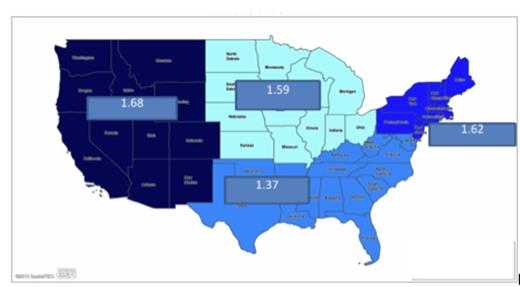Abstract
Introduction
The NCCN's guideline recommendation for monitoring response to TKI therapy in CML is quantitative PCR BCR-ABL testing every 3 months for 3 years, and every 3-6 months after complete cytogenetic remission (CCyR) has been achieved. (http://www.nccn.org/professionals/physician_gls/pdf/cml.pdf p. CML-A) Prior research showed gaps in testing frequency (Chen C, et al. J Clin Oncol. 2013;31(suppl, abstr 7096)). Our objective was to analyze testing rates among CML patients in a large, national database, to determine if there are differences across age, gender, or US regions (Northeast, Southeast, Midwest and West).
Methods
We analyzed BCR-ABL lab test results for 5,446 CML patients, identified via ICD-9 codes in the nationwide Medivo Lab Exchange (Medivo Inc., New York, NY) between March 2011 - February 2014. Patients were categorized by the number of annual BCR-ABL tests per year (<1, 1, 2, 3, 4 and >4), and correlations between testing frequency and age, gender, and region were conducted. ANOVA was performed to assess difference in BCR-ABL testing frequency between male and female CML patients as well as patients <40 yrs. vs. > 40 yrs. Regression analysis was performed to assess regional differences in testing frequency.
Results
Overall 79.4% (4,325 out of 5,446) of CML patients were tested at least once over the 3-year period. Across all CML patients, the average annual testing frequency was 1.6 tests/yr. The categories of testing frequency (Fig. 1) were: <1/yr., 1,121 (21%); 1/yr., 2,400 (44%); 2/yr., 1,097 (20%); 3/yr., 584 (11%); 4/yr., 160 (3%); and >4/yr., 84 (2%). Male patients (n = 2,832) and female patients (n= 2,614) were tested at similar rates/year (average test frequency 1.59 vs. 1.61, p = 0.6). Patients <40 yrs. (n= 621) were tested at a similar rate as those > 40 yrs. (n=4,825), average test frequency 1.63 vs. 1.59 times/yr.; p = 0.4. Interaction between patients' gender and age was not significant (p = 0.7). BCR-ABL testing frequency varied significantly across regions. The regression analysis showed significant downward trends in average annual frequency of testing (p<0.001) from the highest in the West (1.68 tests/yr.), less in the Northeast (1.62 tests/yr.), less in the Southeast (1.59 tests/yr.) to the lowest in the Midwest (1.37 tests/yr.) (Fig 2).
Conclusions
The NCCN guidelines support BCR-ABL testing every 3 months for the first 3 years of therapy, and every 3-6 months thereafter. Thus, in a cross section of CML patients, compliant monitoring would result in at least 2 tests per year. In this large group of CML patients, only 36% of patients had > 2 tests/yr., with only 5% having >4 tests/yr.; 65% were tested once per year or less. There were no significant differences in testing frequency seen in patients by gender or age. However, there were significant differences seen across US regions, with the highest rate in the West and the lowest in the Midwest. Future analyses should include longitudinal views of BCR-ABL results to highlight trends in responses to therapy and CCyR status, and payor type analyses to assess additional characteristics associated with low vs. high rates of BCR-ABL testing.
Smyth:Medivo, Inc.: Employment. Bhan:Medivo, Inc. : Employment. Sorokina:Medivo, Inc.: Employment. Parikh:Medivo, Inc.: Employment. Radich:Novartis: Research Funding; Ariad Pharmaceuticals, Inc.: Consultancy; Bristol-Myers Squibb Company: Consultancy; Incyte Corporation: Consultancy; Novartis Pharmaceuticals Company: Consultancy; Pfizer, Inc.: Consultancy.
Author notes
Asterisk with author names denotes non-ASH members.



This feature is available to Subscribers Only
Sign In or Create an Account Close Modal